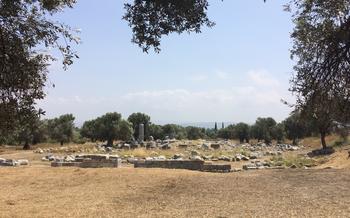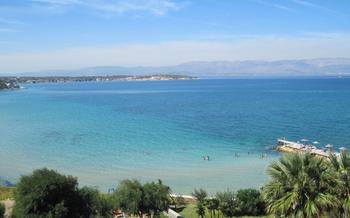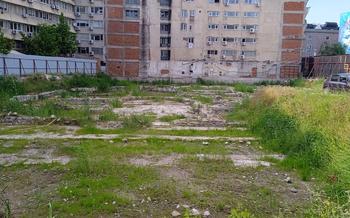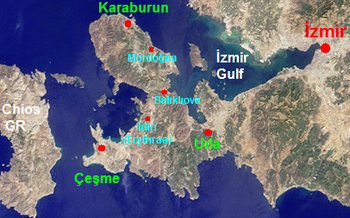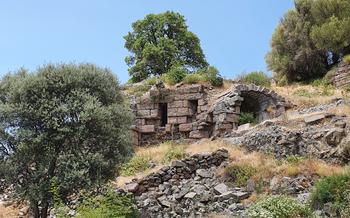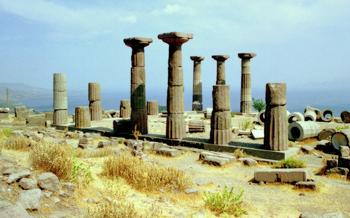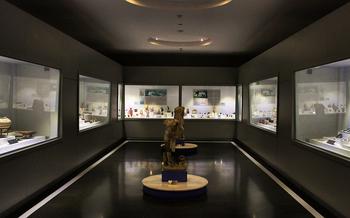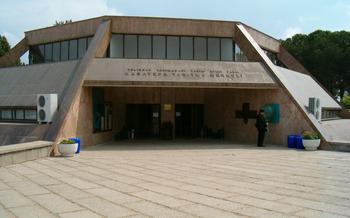
Erythrai Ancient City
- Historical Significance
- Location and Accessibility
- Exploring the Ruins
- Temple of Athena
- Agora and Marketplace
- Theater and Odeon
- City Walls and Fortifications
- Museum of Erythrai
- Panoramic Views
- Nearby Attractions
- Festivals and Events
- Local Cuisine
- Accommodation Options
- Practical Tips and Recommendations
- Insider Tip: Revealing the Hidden Treasures of Erythrai
Historical Significance
Erythrai, an ancient Ionian city of great significance, boasts a rich history dating back to the 11th century BC. Founded by Ionian settlers from Athens, it quickly rose to prominence as a maritime and commercial center. Erythrai's strategic location on the Aegean coast facilitated trade and cultural exchange, transforming it into a vibrant and prosperous city-state.
During the Hellenistic period, Erythrai came under the rule of various empires, including the Lydians, Persians, and Romans. Despite these changes in political power, the city maintained its cultural identity and autonomy. Archaeological discoveries, including inscriptions, coins, and pottery, have shed light on Erythrai's past, revealing its social, economic, and religious practices.
Among the most notable archaeological findings are the well-preserved remains of the Temple of Athena, the city's patron goddess. Excavations have also uncovered a theater, an agora, and defensive fortifications, providing valuable insights into Erythrai's urban planning and architectural achievements. These discoveries have contributed to our understanding of ancient Ionian civilization and its enduring legacy in the region.
Location and Accessibility
Erythrai, an ancient Ionian city, is situated on the western coast of Turkey, approximately 80 kilometers south of Izmir, the third largest city in the country. It lies within the borders of the modern-day town of Çeşme, which is renowned for its picturesque beaches and vibrant nightlife. To reach Erythrai, visitors can take a scenic drive along the Aegean coast, enjoying the breathtaking views of the turquoise waters and lush green hills. Alternatively, public transportation options are available, with buses and minibuses departing regularly from Izmir and Çeşme. Upon arrival in Çeşme, visitors can easily access Erythrai by taking a short taxi or bus ride to the ancient city's entrance.
Exploring the Ruins
Walking through the ancient city of Erythrai is like stepping back in time. The ruins, remarkably well-preserved, offer a glimpse into the daily lives of the people who once lived here. Major landmarks include the Temple of Athena, the agora, the theater, and the city walls.
The Temple of Athena, dedicated to the patron goddess of Erythrai, is a marvel of ancient architecture. Its grand columns and intricate carvings speak to the skill and artistry of the builders. The agora, once the bustling center of trade and commerce, is lined with shops, stoas, and public buildings. Here, you can imagine the hustle and bustle of daily life in ancient Erythrai.
The theater, with its well-preserved seating tiers, was once the venue for performances, festivals, and public gatherings. The acoustics are still excellent, and visitors can often enjoy concerts or plays held in the theater during the summer months. The city walls, with their imposing gates, towers, and ramparts, once protected Erythrai from invaders. They offer stunning views of the surrounding landscape and are a testament to the strategic importance of the city.
Temple of Athena
The Temple of Athena is undoubtedly the most iconic and well-preserved structure within the ancient city of Erythrai. Constructed in the 6th century BC, it stands as a testament to the architectural prowess and religious devotion of the Ionians. Dedicated to the goddess Athena, the temple's grandeur and sophistication reflect the city's prosperity and significance during the Hellenistic period.
The temple's architectural features are a blend of Doric and Ionic influences. Its imposing columns, intricately carved capitals, and well-proportioned facade showcase the meticulous craftsmanship of ancient Greek builders. The temple's orientation towards the rising sun further emphasizes its sacred significance and connection to the divine.
Excavations and restoration efforts have uncovered a wealth of artifacts and inscriptions that shed light on the temple's history and religious practices. These discoveries have provided valuable insights into the rituals, offerings, and ceremonies performed within the temple's sacred precincts.
The Temple of Athena remains a symbol of Erythrai's rich cultural heritage and serves as a reminder of the enduring legacy of ancient Ionian civilization. Its presence amidst the ruins invites visitors to contemplate the deep spiritual and cultural roots that shaped this ancient city.
Agora and Marketplace
The agora, the bustling heart of ancient Erythrai, was a vibrant hub of trade, commerce, and social interaction. Located at the city's center, it served as a marketplace where merchants from near and far gathered to buy and sell their wares.
The agora was a vast open space surrounded by colonnaded stoas, sheltered walkways that lined the perimeter. These stoas provided shade from the scorching sun and housed shops, workshops, and other businesses. Vendors displayed their goods on tables or in stalls, offering a diverse array of products, from fresh produce and textiles to pottery, jewelry, and imported luxuries.
In addition to its commercial function, the agora was also a place for public gatherings, political debates, and religious ceremonies. Citizens from all walks of life congregated here to exchange news, discuss issues of the day, and participate in the city's governance. The agora was a place where the pulse of Erythrai could be felt, a vibrant testament to the city's prosperity and dynamism.
As you wander through the ruins of the agora, you can almost hear the echoes of the past, the bustling sounds of merchants hawking their wares, the laughter and chatter of shoppers, and the passionate speeches of politicians. It is easy to imagine the lively atmosphere that once permeated this space, a testament to the vibrant life that coursed through the veins of ancient Erythrai.
Theater and Odeon
The impressive Theater and Odeon, located within the ancient city of Erythrai, stand as testaments to the vibrant cultural and artistic life of this once-prosperous Ionian city.
The Theater, built in the classical Hellenistic style, boasts an impressive seating capacity of over 5,000 spectators. Its carefully crafted tiers of stone seats rise steeply from the orchestra, providing a panoramic view of the stage and the surrounding landscape.
The stage itself is adorned with intricate carvings and sculptures, depicting scenes from Greek mythology and the lives of renowned playwrights and actors. The acoustics of the theater are exceptional, allowing the voices of performers to carry effortlessly throughout the auditorium, ensuring that every word and nuance is heard by the audience.
Adjacent to the theater is the smaller Odeon, a covered structure designed for musical performances and recitals. With its intimate setting and superior acoustics, the Odeon was the perfect venue for chamber music, poetry readings, and small-scale theatrical productions.
Even today, these ancient performance venues continue to host cultural events, festivals, and performances, bringing to life the rich artistic heritage of Erythrai and offering visitors a glimpse into the vibrant entertainment culture of the ancient world.
City Walls and Fortifications
The ancient city of Erythrai was encircled by a formidable system of defensive structures, safeguarding its inhabitants from external threats. These fortifications consisted of sturdy city walls, imposing towers, and strategic ramparts, which effectively protected the city's perimeter.
The city walls, constructed using massive stone blocks, stood tall and unyielding, serving as an impenetrable barrier against invading forces. Along the walls, a series of towers provided elevated vantage points for vigilant sentries, who kept watch over the surrounding landscape, ready to alert the city of approaching danger.
The ramparts, positioned at intervals along the walls, further reinforced the city's defenses. These elevated platforms, often topped with battlements, allowed defenders to launch projectiles and effectively repel enemy attacks.
The gates, carefully positioned at specific points along the walls, provided controlled access to the city. These gateways were heavily fortified with sturdy doors and elaborate locking mechanisms, ensuring that only authorized individuals could enter or exit the city.
The defensive structures of Erythrai played a pivotal role in safeguarding the city throughout its history. They withstood numerous sieges and invasions, enabling Erythrai to maintain its independence and prosperity for centuries. Today, these fortifications stand as a testament to the engineering prowess and strategic foresight of the ancient Erythraians.
Museum of Erythrai
The Museum of Erythrai is a treasure trove of archaeological artifacts that provide a glimpse into the vibrant history and culture of this ancient city. Located within the site itself, the museum showcases a diverse collection of sculptures, pottery, and inscriptions that have been unearthed during excavations.
One of the highlights of the museum is the impressive collection of sculptures, which include statues of gods, goddesses, and prominent figures from Erythrai's past. These sculptures offer a glimpse into the artistic prowess of the ancient inhabitants and provide valuable insights into their religious beliefs and practices.
Another significant exhibit at the museum is the collection of pottery. From delicate vases and amphorae to utilitarian jars and cooking vessels, these artifacts provide a tangible connection to the daily lives of the Erythraians. The intricate designs and motifs on the pottery offer clues about their artistic inclinations and cultural influences.
Finally, the museum houses a collection of inscriptions that provide valuable historical information about Erythrai. These inscriptions include decrees, laws, and dedications that shed light on the political, social, and economic aspects of the city's existence. By studying these inscriptions, historians and archaeologists have been able to reconstruct the intricate tapestry of Erythrai's past.
A visit to the Museum of Erythrai is a must for anyone who wants to delve deeper into the history and culture of this remarkable ancient city. The museum's exhibits offer a tangible connection to the past, providing visitors with a unique glimpse into the lives and achievements of the Erythraians.
Panoramic Views
Within the ancient city of Erythrai, visitors can discover several elevated vantage points that offer stunning panoramas of the surrounding landscape. These elevated spots provide a unique perspective on the ruins and allow visitors to appreciate the city's layout and its relationship to the natural environment.
One of the most popular vantage points is the acropolis, which stands as the highest point within the ancient city. From the acropolis, visitors can enjoy breathtaking views of the entire Erythrai ruins, the sparkling Aegean Sea, and the lush green valleys that stretch beyond.
Another excellent spot for panoramic views is the theater, situated on the slopes of the acropolis. From the theater's upper tiers, visitors can capture panoramic shots of the stage, the surrounding countryside, and the distant mountains.
The city walls, which once protected Erythrai from invaders, also offer fantastic panoramic views. Walking along the ramparts, visitors can admire the city's fortifications up close while taking in the stunning vistas of the surrounding landscape.
These panoramic viewpoints provide an opportunity for visitors to not only appreciate the beauty of Erythrai's ruins but also to gain a deeper understanding of the city's geography and its historical significance.
Nearby Attractions
Beyond the captivating ruins of Erythrai, the surrounding region offers a wealth of additional attractions to explore. Journey to the nearby ancient city of Teos, where you can marvel at the remains of its impressive theater, agora, and temple dedicated to Dionysus. Immerse yourself in the picturesque landscapes of Şirince, a charming village nestled amidst vineyards and renowned for its delicious fruit wines. Bask in the sun-kissed shores of Çeşme, a vibrant coastal town boasting pristine beaches, crystal-clear waters, and a lively atmosphere. Discover the natural wonders of Dilek Peninsula National Park, a breathtaking sanctuary teeming with lush forests, secluded coves, and panoramic vistas. Embark on a boat tour to the enchanting Gümüldür, a chain of idyllic islands offering pristine swimming spots and a tranquil retreat from the mainland.
Festivals and Events
Erythrai comes alive during various cultural festivals and events throughout the year, offering visitors a chance to immerse themselves in the vibrant local culture. The Erythrai Festival, held annually in the summer, is a celebration of the city's rich history and heritage. The festival features music concerts, traditional dance performances, and theatrical reenactments of ancient myths and legends. Visitors can also savor delicious local cuisine, shop for handmade crafts, and witness traditional wedding ceremonies and other cultural rituals.
Another popular event is the Erythrai Wine Festival, held in the fall to celebrate the region's renowned winemaking tradition. Visitors can sample a variety of local wines, learn about the winemaking process, and enjoy live music and entertainment. The festival also showcases local cuisine and traditional dances, creating a lively and festive atmosphere.
These festivals and events provide an excellent opportunity for visitors to experience the rich cultural heritage of Erythrai and connect with the local community. Whether it's through music, dance, or culinary delights, Erythrai's festivals offer a vibrant and authentic glimpse into the region's past and present.
Local Cuisine
The region surrounding Erythrai is renowned for its delectable cuisine, a harmonious blend of Turkish and Mediterranean flavors. Fresh seafood, a staple in the local diet, takes center stage in many dishes. Grilled fish, succulent shrimp, and tender calamari, all caught from the nearby Aegean Sea, are culinary delights not to be missed.
Olive oil, a liquid gold produced in abundance in the region, adds a distinctive flavor to local dishes. Drizzle it over fresh salads, grilled meats, or simply enjoy it with some crusty bread for a taste of authentic Turkish cuisine.
The fertile lands surrounding Erythrai yield an array of fresh produce, including succulent tomatoes, crisp cucumbers, and sweet peppers. These ingredients form the basis of many traditional dishes, such as stuffed vine leaves, a labor of love that showcases the culinary expertise of local cooks.
For a sweet treat, indulge in lokma, bite-sized fried dough balls generously coated in fragrant syrup. These delectable morsels are a popular dessert in Turkey and a must-try for visitors.
When in Erythrai, take the opportunity to dine at one of the charming restaurants or cafes nestled within the ancient city walls. Savor the flavors of the region while enjoying the enchanting ambiance of this historical site.
Accommodation Options
Erythrai offers a range of accommodation options to suit different budgets and preferences. For a comfortable and immersive stay, consider booking a room at one of the charming guesthouses or boutique hotels located within the ancient city walls. These establishments often feature traditional Turkish architecture, cozy rooms, and personalized service.
If you prefer a more budget-friendly option, there are several hostels and guesthouses in the nearby town of Çeşme that offer affordable dormitory-style accommodations. These hostels often have a vibrant social atmosphere and provide opportunities to meet fellow travelers.
For those seeking a unique and unforgettable experience, camping is an excellent option. Several designated camping grounds are located in the vicinity of Erythrai, offering breathtaking views of the ancient city and the surrounding countryside. Camping allows visitors to immerse themselves in the natural beauty of the region and enjoy the tranquility of the surroundings.
Regardless of your choice of accommodation, it is advisable to book in advance, especially during the peak tourist season from June to September. This will ensure that you have a comfortable place to stay after a long day of exploring the ancient ruins and the surrounding area.
Practical Tips and Recommendations
To make the most of your visit to Erythrai, it's essential to plan ahead and consider these practicalities:
-
Best Time to Visit: Spring (April-May) and autumn (September-October) offer pleasant weather for exploring the ruins. In summer (June-August), temperatures can soar, so it's best to start your visit early morning or late afternoon, avoiding the midday heat.
-
Weather Conditions and Clothing: Pack light, comfortable clothing suitable for walking on uneven terrain. Bring sunscreen, sunglasses, and a hat to protect yourself from the sun. In spring and autumn, layers are recommended as temperatures can fluctuate.
-
Accessibility: Erythrai is generally accessible for visitors with disabilities, with ramps and designated paths in some areas. However, certain sections of the site may be challenging to navigate due to uneven ground and historical structures.
-
Additional Tips: Carry water and snacks as there are limited food and beverage options within the ancient city. Comfortable shoes are a must, as you'll be doing a lot of walking. Photography enthusiasts should bring a camera to capture the stunning ruins and panoramic views.
Insider Tip: Revealing the Hidden Treasures of Erythrai
Discover the Enchanting Grotto: Venture beyond the main archaeological site and seek out the hidden grotto, located near the ancient harbor. This secluded spot, with its crystal-clear waters and colorful marine life, offers a tranquil retreat and a chance to immerse yourself in the natural beauty of Erythrai.
Witness the Sunset at the Acropolis: As the sun begins its descent, make your way to the acropolis, the highest point of the ancient city. The panoramic views from here are simply breathtaking, painting a picture of the surrounding landscape bathed in golden hues. Capture this magical moment with your camera and cherish the memories for a lifetime.
Explore the Olive Groves: The countryside surrounding Erythrai is dotted with olive groves, stretching as far as the eye can see. Take a leisurely stroll amidst these groves, admiring the gnarled trees and learning about the region's rich olive oil production. Don't miss the opportunity to sample some of the local olive oil, renowned for its exceptional flavor and quality.
Engage with the Locals: Connect with the friendly locals of Erythrai to gain insights into their culture and traditions. Visit the local markets, where you can barter for fresh produce, handmade crafts, and souvenirs. Engage in conversations with the locals, who are always eager to share stories and anecdotes about their beloved city.
